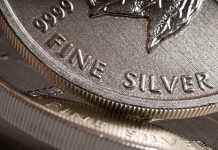Yesterday was just another day with the same topics. The US debt ceiling talks continued; US President Joe Biden expressed optimism about reaching a deal. US Treasury Secretary Janet Yellen said that the Treasury will soon be running out of money and won’t be able to service its debt.
The US 2-year yield pushed higher to above 4.30%, the S&P500 was little changed near levels last seen last summer, while Nasdaq 100 advanced to levels above last summer peaks and is now trading at the highest levels since April 2021.
Interestingly however, gold doesn’t see much demand despite the looming debt ceiling talks. Inflows remain limited and the price pressures are to the downside. The stronger US dollar and higher yields weigh on gold appetite at a time investors would be ready to take on higher opportunity costs due to rising default risk.
But the fact that equities remain strong despite the rising yields, and that gold sees limited safe-haven inflows point that investors watch the US debt ceiling saga as an American film knowing that there will eventually be a happy ending…
Two more hikes?
Federal Reserve (Fed) officials remain surprisingly hawkish. It’s just yesterday that St Louis Fed President Bullard – who is happily not a voting member this year – said he would back two more rate hikes in 2023. Minneapolis Fed’s Kashkari said that even if the Fed decided to bypass a rate hike in June, it should make sure to investors that tightening is not over.
That, with the fact that the US Treasury will be refilling its General Account as soon as a debt ceiling deal is reached, means that the financial and liquidity conditions will tighten in the next few months, rather than the contrary.
And that’s not necessarily good news for stocks.
In the short run, however, a resolution to the debt ceiling saga will likely trigger a further positive push in stocks before the liquidity headache kicks in. In this context, we will likely see the S&P500 clear the 4200 resistance with the news of an eventual debt ceiling deal, before the winds turn south.
Flash PMIs
In Japan, the flash PMI data showed that services expanded faster in May, while manufacturing unexpectedly turned to expansion. With such a massive support from the Bank of Japan (BoJ), it’s good news that the Japanese manufacturers are feeling better despite the soft yen which makes the cost of raw material more expensive by the day. The USDJPY is approaching the 139 level. Softer yen means that inflation in Japan will only get worse if the BoJ doesn’t step in. But until then, the widening spread between the Japanese and US rates support a further advance in USDJPY toward the 140 psychological mark.
Elsewhere, the EURUSD remains bid around the 1.08 mark, with manufacturing PMI seen slightly less in contraction than the previous month. A better-than-expected set of data could help fuel the European Central Bank (ECB) hawks and give a positive spin to the euro at the current levels. The ECB Chief Lagarde and Spanish central bank head de Cos reiterated their hawkish stance over the past couple of days saying that the ECB is already at an advanced tightening level, but that the bank will continue raising rates and will keep them at restrictive levels to bring inflation back to the 2% policy target. Given that the ECB doesn’t deal with a banking crisis and political shenanigans, the hawkish call from its members is more credible than their colleagues across the Atlantic Ocean. Therefore, the medium-term outlook for the euro remains positive, yet the short-term direction will mostly depend on the US dollar appetite into the US debt ceiling deadline. The rising US yields and safe haven demand support the US dollar in the actual context of uncertainty, and the dollar could hold on to its gains in the coming days.
In energy
US crude remains in a tight range above the $70pb level. Bulls are skeptical as the looming debt ceiling talks in the US are not ideal for appetite, but bears are rare below the $70pb level as the lower the price the higher the risk of another OPEC intervention at the next meeting which will take place at the beginning of next month.
Until then, we will likely see strong resistance into the 50-DMA, which stands around $74.50 mark, and into the 100-DMA, which is just shy of $76pb.














